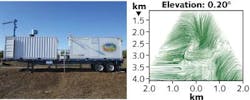Various methods exist to measure the wind remotely with atmospheric light detection and ranging (lidar) systems, with the most popular technique involving the detection of the Doppler frequency shift of the backscattered laser radiation. Unfortunately, Doppler lidar is only capable of detecting one wind-velocity component from a given pointing direction, called the “radial” or “line-of-sight” component; the components of air motion perpendicular to the laser beam cannot be detected directly. Therefore, Doppler lidar systems can only directly sense a third of the information needed to produce a full wind-velocity vector.
But a lidar system called Raman-shifted Eye-safe Aerosol Lidar (REAL), originally developed at the National Center for Atmospheric Research (NCAR; Boulder, CO) and refined at California State University–Chico (CSU Chico; Chico, CA), images the movement of atmospheric features to determine two-component wind data and horizontal wind-vector maps.1
Doppler deficiencies
Air motion (a wind vector) has three components in a Cartesian coordinate system: east-west (x), north-south (y), and up-down (z); in a lidar's native spherical-coordinate system they are azimuthal (ф), elevation (φ), and range (r). In most applications requiring remote wind data, radial velocity alone is of limited value because wind speed and direction, which require measurements of at least two components, are needed. One way to get around this limitation of Doppler lidar is to scan the laser beam, systematically redirecting it at many angles to create a multidimensional image of the radial velocity field and obtaining speed and direction by curve fitting. However, the data used to fit the curve do not fall at the same location since the lidar has to "look" in different directions to see the different velocity components.
The Doppler method also requires full azimuthal scans and invokes the assumption that the wind field is spatially homogeneous over the scanned area. For long-range lidar systems, this could be several kilometers from one side of the scan to the other.
The non-Doppler alternative
A long-standing lidar technique that has languished until recently involves scanning a non-Doppler, elastic backscatter lidar over a region and applying image-processing algorithms to the resulting sequence frames to estimate the movement of macroscopic aerosol features.
A primary challenge overcome by REAL was the ability to transmit sufficient pulse energy to see far (several kilometers) and scan rapidly (one scan per 20 s) and remain within the ANSI standards for eye safety. The transmitter in the REAL system uses a commercially available Nd:YAG pump laser and a custom stimulated-Raman-scattering wavelength shifter—a gas cell that converts the 1 μm pump beam to a 1.54 μm eyesafe beam—that overcomes traditional problems of sooting and poor beam quality typically associated with previous generations of Raman shifters.
A second concern was whether macroscopic aerosol features move with the wind sufficiently to be considered good tracers of air motion. Unlike Doppler lidar, the feature-tracking technique depends on coherent aerosol features in the image data that may be tens to hundreds of meters in size. To address this challenge, the researchers collected REAL data coincident with tower-mounted in situ sonic anemometers to test the approach. In addition, an "optical-flow" image-processing algorithm that may prove more effective than traditional "cross-correlation" techniques was tested.2 The results confirmed the method’s functionality (see figure).
"In 2012, the REAL instrument at CSU Chico will acquire new mirrors from Hextek (Tucson, AZ) for the laser beam-steering unit," says Shane Mayor, physics research professor at CSU Chico. The former Zerodur mirrors were glued with silicone adhesive to honeycomb panels, making them difficult to model and service, and increasing ucertainty in the mirror flatness both during fabrication and over time. "The REAL mirrors must have <2 µm deviation over a 17 × 24 in.2 area to focus all of the backscattered laser radiation to a 200 µm diameter photodetector," says Mayor. "The proprietary gas-fusion process from Hextek meets our flatness specification, improving REAL's performance for future offshore wind-assessment applications or for very short-term wind forecasting to optimize wind-energy production."
The Physical and Dynamic Meteorology Program at the National Science Foundation funded this work and the CSU Chico physics department hosts the Atmospheric Lidar Research Group. An article on the results in the Journal of Atmospheric and Oceanic Technology is forthcoming.
REFERENCES
1. S.D. Mayor et al., FiO/LS Joint Poster Session 11, poster JWA19 (October 2011).
2. P. Dérian et al., 25th ILRC, oral presentation S3O-04 (July 2010).

